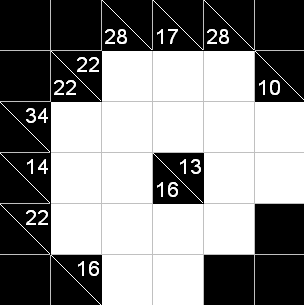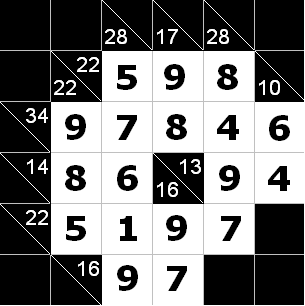HDU3338 Kakuro Extension —— 最大流、方格填数类似数独
题目链接:https://vjudge.net/problem/HDU-3338
Kakuro Extension
Time Limit: 2000/1000 MS (Java/Others) Memory Limit: 32768/32768 K (Java/Others)
Total Submission(s): 2419 Accepted Submission(s): 840
Special Judge
Kakuro puzzle is played on a grid of "black" and "white" cells. Apart from the top row and leftmost column which are entirely black, the grid has some amount of white cells which form "runs" and some amount of black cells. "Run" is a vertical or horizontal maximal one-lined block of adjacent white cells. Each row and column of the puzzle can contain more than one "run". Every white cell belongs to exactly two runs — one horizontal and one vertical run. Each horizontal "run" always has a number in the black half-cell to its immediate left, and each vertical "run" always has a number in the black half-cell immediately above it. These numbers are located in "black" cells and are called "clues".The rules of the puzzle are simple:
1.place a single digit from 1 to 9 in each "white" cell
2.for all runs, the sum of all digits in a "run" must match the clue associated with the "run"
Given the grid, your task is to find a solution for the puzzle.


Picture of the first sample input Picture of the first sample output
.......— "white" cell;
XXXXXXX— "black" cell with no clues;
AAA\BBB— "black" cell with one or two clues. AAA is either a 3-digit clue for the corresponding vertical run, or XXX if there is no associated vertical run. BBB is either a 3-digit clue for the corresponding horizontal run, or XXX if there is no associated horizontal run.
The first row and the first column of the grid will never have any white cells. The given grid will have at least one "white" cell.It is guaranteed that the given puzzle has at least one solution.
题意:
给定一个n*m的矩阵,为其中的白格填上范围为1~9的数,并且满足横之和、纵之和的限制,限制记录在黑格子上。类似于数独游戏,要求输出一组可行解。
题解:
可知横之和的和必定等于纵之和的和,因为横之和的和是所有白格子的和, so does 纵之和的和。因此,我们可以用网络流来解题,建图如下:
1.先对行进行分块,然后再对列进行分块,因为同一行或同一列不一定属于同一个run。
2.建立超级源点,超级源点连向每一个横之和结点,容量为横之和。
3.对于每个白格,将其横坐标所属的横之和结点连向其纵坐标所属的纵之和结点,容量下界为1,容量上界为9。
4.建立超级汇点,每个纵之和结点连向超级汇点,容量为纵之和。
5.回顾上述建图方法,发现白格建的边容量下界(一般情况都是没有下界的,即为0),不好处理。但是可以知道容量下界都为1,那么,我们可以先为每个白格子都分一个1,表明这个1是必须的,毋庸置疑。因此,就可以去掉白格子所建的边的容量下界了,而容量上界也因此改为8.
6.由于“横之和的和=纵之和的和”,“横之和的和”的流量由超级源点发出,“纵之和的和”的流量由超级汇点接收,且可知如果有解,那么白格子的存在(调节)必定能使每条:超级汇点-->“横之和”结点 的边满流,而满流时必定是最大流。因此我们可以跑最大流算法,然后再提取每条白格子所建边的流量信息,即可知道每个白格子应该填上什么数。
写法一:

1 #include <iostream> 2 #include <cstdio> 3 #include <cstring> 4 #include <algorithm> 5 #include <vector> 6 #include <cmath> 7 #include <queue> 8 #include <stack> 9 #include <map> 10 #include <string> 11 #include <set> 12 using namespace std; 13 typedef long long LL; 14 const int INF = 2e9; 15 const LL LNF = 9e18; 16 const int mod = 1e9+7; 17 const int MAXM = 1e5+10; 18 const int MAXN = 1e4+10; 19 20 struct Edge 21 { 22 int to, next, cap, flow; 23 }edge[MAXM]; 24 int tot, head[MAXN]; 25 int gap[MAXN], dep[MAXN], pre[MAXN], cur[MAXN]; 26 27 void init() 28 { 29 tot = 0; 30 memset(head, -1, sizeof(head)); 31 } 32 33 void add(int u, int v, int w) 34 { 35 edge[tot].to = v; edge[tot].cap = w; edge[tot].flow = 0; 36 edge[tot].next = head[u]; head[u] = tot++; 37 edge[tot].to = u; edge[tot].cap = 0; edge[tot].flow = 0; 38 edge[tot].next = head[v]; head[v] = tot++; 39 } 40 41 int sap(int start, int end, int nodenum) 42 { 43 memset(dep, 0, sizeof(dep)); 44 memset(gap, 0, sizeof(gap)); 45 memcpy(cur, head, sizeof(head)); 46 int u = pre[start] = start, maxflow = 0,aug = INF; 47 gap[0] = nodenum; 48 while(dep[start]<nodenum) 49 { 50 loop: 51 for(int i = cur[u]; i!=-1; i = edge[i].next) 52 { 53 int v = edge[i].to; 54 if(edge[i].cap-edge[i].flow && dep[u]==dep[v]+1) 55 { 56 aug = min(aug, edge[i].cap-edge[i].flow); 57 pre[v] = u; 58 cur[u] = i; 59 u = v; 60 if(v==end) 61 { 62 maxflow += aug; 63 for(u = pre[u]; v!=start; v = u,u = pre[u]) 64 { 65 edge[cur[u]].flow += aug; 66 edge[cur[u]^1].flow -= aug; 67 } 68 aug = INF; 69 } 70 goto loop; 71 } 72 } 73 int mindis = nodenum; 74 for(int i = head[u]; i!=-1; i = edge[i].next) 75 { 76 int v=edge[i].to; 77 if(edge[i].cap-edge[i].flow && mindis>dep[v]) 78 { 79 cur[u] = i; 80 mindis = dep[v]; 81 } 82 } 83 if((--gap[dep[u]])==0)break; 84 gap[dep[u]=mindis+1]++; 85 u = pre[u]; 86 } 87 return maxflow; 88 } 89 90 char str[110]; 91 int Map[110][110], run[110][110][2]; //用于记录原始图案 92 int xid[110][110], yid[110][110]; 93 int xrun[11000], yrun[11000], index[110][110]; 94 int main() 95 { 96 int n, m; 97 while(scanf("%d%d", &n,&m)!=EOF) 98 { 99 for(int i = 1; i<=n; i++) 100 for(int j = 1; j<=m; j++) 101 { 102 scanf("%s", str); 103 if(str[0]=='.') Map[i][j] = 1; 104 else 105 { 106 Map[i][j] = 0; 107 if(str[0]!='X') run[i][j][0] = (str[0]-'0')*100+(str[1]-'0')*10+(str[2]-'0'); 108 if(str[4]!='X') run[i][j][1] = (str[4]-'0')*100+(str[5]-'0')*10+(str[6]-'0'); 109 } 110 } 111 112 int xcnt = 0, ycnt = 0; 113 for(int i = 2; i<=n; i++) 114 for(int j = 2; j<=m; j++) 115 { 116 if(Map[i][j]) 117 { 118 if(!Map[i][j-1]) //横流 119 { 120 xid[i][j] = xcnt; 121 xrun[xcnt++] = run[i][j-1][1]; 122 }else xid[i][j] = xid[i][j-1]; 123 xrun[xid[i][j]]--; 124 125 if(!Map[i-1][j]) //纵流 126 { 127 yid[i][j] = ycnt; 128 yrun[ycnt++] = run[i-1][j][0]; 129 }else yid[i][j] = yid[i-1][j]; 130 yrun[yid[i][j]]--; 131 } 132 } 133 134 int start = xcnt+ycnt, end = xcnt+ycnt+1; 135 init(); 136 for(int i = 2; i<=n; i++) 137 for(int j = 2; j<=m; j++) 138 { 139 if(Map[i][j]) 140 { 141 add(xid[i][j], xcnt+yid[i][j], 8); 142 index[i][j] = tot-2; //记录这个空格所对应的边 143 } 144 } 145 for(int i = 0; i<xcnt; i++) add(start, i, xrun[i]); 146 for(int i = 0; i<ycnt; i++) add(xcnt+i, end, yrun[i]); 147 148 sap(start, end, xcnt+ycnt+2); 149 for(int i = 1; i<=n; i++) 150 { 151 for(int j = 1; j<=m; j++) 152 { 153 printf("%c", Map[i][j]?(edge[index[i][j]].flow+'1'):'_'); 154 if(j<m) printf(" "); 155 } 156 printf("\n"); 157 } 158 } 159 }
写法二:

1 #include <iostream> 2 #include <cstdio> 3 #include <cstring> 4 #include <algorithm> 5 #include <vector> 6 #include <cmath> 7 #include <queue> 8 #include <stack> 9 #include <map> 10 #include <string> 11 #include <set> 12 using namespace std; 13 typedef long long LL; 14 const int INF = 2e9; 15 const LL LNF = 9e18; 16 const int mod = 1e9+7; 17 const int MAXM = 1e5+10; 18 const int MAXN = 1e4+10; 19 20 struct Edge 21 { 22 int to, next, cap, flow; 23 }edge[MAXM]; 24 int tot, head[MAXN]; 25 int gap[MAXN], dep[MAXN], pre[MAXN], cur[MAXN]; 26 27 void init() 28 { 29 tot = 0; 30 memset(head, -1, sizeof(head)); 31 } 32 33 void add(int u, int v, int w) 34 { 35 edge[tot].to = v; edge[tot].cap = w; edge[tot].flow = 0; 36 edge[tot].next = head[u]; head[u] = tot++; 37 edge[tot].to = u; edge[tot].cap = 0; edge[tot].flow = 0; 38 edge[tot].next = head[v]; head[v] = tot++; 39 } 40 41 int sap(int start, int end, int nodenum) 42 { 43 memset(dep, 0, sizeof(dep)); 44 memset(gap, 0, sizeof(gap)); 45 memcpy(cur, head, sizeof(head)); 46 int u = pre[start] = start, maxflow = 0,aug = INF; 47 gap[0] = nodenum; 48 while(dep[start]<nodenum) 49 { 50 loop: 51 for(int i = cur[u]; i!=-1; i = edge[i].next) 52 { 53 int v = edge[i].to; 54 if(edge[i].cap-edge[i].flow && dep[u]==dep[v]+1) 55 { 56 aug = min(aug, edge[i].cap-edge[i].flow); 57 pre[v] = u; 58 cur[u] = i; 59 u = v; 60 if(v==end) 61 { 62 maxflow += aug; 63 for(u = pre[u]; v!=start; v = u,u = pre[u]) 64 { 65 edge[cur[u]].flow += aug; 66 edge[cur[u]^1].flow -= aug; 67 } 68 aug = INF; 69 } 70 goto loop; 71 } 72 } 73 int mindis = nodenum; 74 for(int i = head[u]; i!=-1; i = edge[i].next) 75 { 76 int v=edge[i].to; 77 if(edge[i].cap-edge[i].flow && mindis>dep[v]) 78 { 79 cur[u] = i; 80 mindis = dep[v]; 81 } 82 } 83 if((--gap[dep[u]])==0)break; 84 gap[dep[u]=mindis+1]++; 85 u = pre[u]; 86 } 87 return maxflow; 88 } 89 90 char str[110]; 91 int Map[110][110], run[110][110][2]; 92 int xid[110][110], yid[110][110]; 93 int xbelong[11000], ybelong[11000], xrun[11000], yrun[11000]; 94 int result[110][110]; 95 int main() 96 { 97 int n, m; 98 while(scanf("%d%d", &n,&m)!=EOF) 99 { 100 for(int i = 1; i<=n; i++) 101 for(int j = 1; j<=m; j++) 102 { 103 scanf("%s", str); 104 if(str[0]=='.') Map[i][j] = 1; 105 else 106 { 107 Map[i][j] = 0; 108 if(str[0]!='X') run[i][j][0] = (str[0]-'0')*100+(str[1]-'0')*10+(str[2]-'0'); 109 if(str[4]!='X') run[i][j][1] = (str[4]-'0')*100+(str[5]-'0')*10+(str[6]-'0'); 110 } 111 } 112 113 int xcnt = 0, ycnt = 0; 114 for(int i = 2; i<=n; i++) 115 for(int j = 2; j<=m; j++) 116 { 117 if(Map[i][j]) 118 { 119 if(!Map[i][j-1]) 120 { 121 xid[i][j] = xcnt; 122 xrun[xcnt] = run[i][j-1][1]; 123 xbelong[xcnt++] = i; 124 }else xid[i][j] = xid[i][j-1]; 125 xrun[xid[i][j]]--; 126 127 if(!Map[i-1][j]) 128 { 129 yid[i][j] = ycnt; 130 yrun[ycnt] = run[i-1][j][0]; 131 ybelong[ycnt++] = j; 132 }else yid[i][j] = yid[i-1][j]; 133 yrun[yid[i][j]]--; 134 } 135 } 136 137 int start = xcnt+ycnt, end = xcnt+ycnt+1; 138 init(); 139 for(int i = 2; i<=n; i++) 140 for(int j = 2; j<=m; j++) 141 { 142 if(Map[i][j]) 143 add(xid[i][j], xcnt+yid[i][j], 8); 144 } 145 for(int i = 0; i<xcnt; i++) add(start, i, xrun[i]); 146 for(int i = 0; i<ycnt; i++) add(xcnt+i, end, yrun[i]); 147 148 sap(start, end, xcnt+ycnt+2); 149 memset(result, 0, sizeof(result)); 150 151 for(int u = 0; u<xcnt; u++) 152 for(int i = head[u]; i!=-1; i=edge[i].next) 153 { 154 int v = edge[i].to-xcnt; 155 if(v>=ycnt) continue; 156 int x = xbelong[u], y = ybelong[v]; 157 if(Map[x][y]) result[x][y] = edge[i].flow+1; 158 } 159 160 for(int i = 1; i<=n; i++) 161 { 162 for(int j = 1; j<=m; j++) 163 { 164 if(Map[i][j]) printf("%d", result[i][j]); 165 else printf("_"); 166 if(j<m) printf(" "); 167 } 168 printf("\n"); 169 } 170 } 171 }




